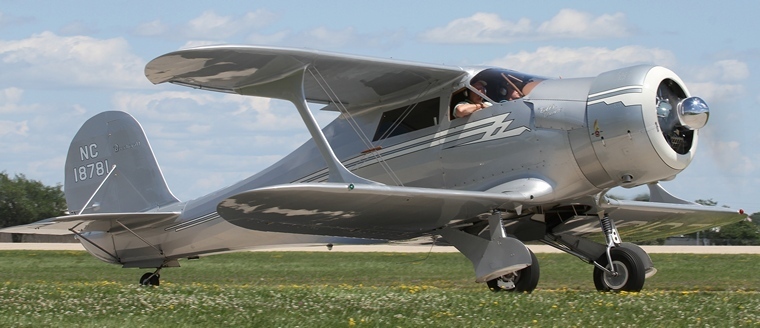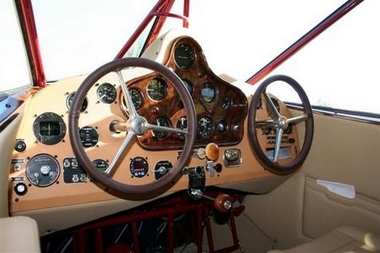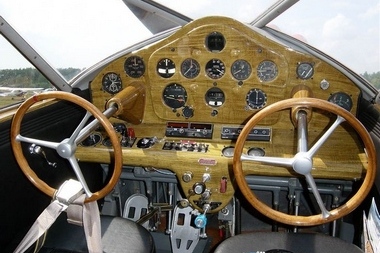








Stinson's Gullwing Reliants-Stars of the golden age of aviation Founded in 1920 by Eddie Stinson, a pilot who was taught to fly by the Wright Brothers, more than 1,300 Reliants would eventually carry the Stinson brand. Eddie Stinson did not live to enjoy the success of his company. He died at age 38 from injuries sustained while making an emergency landing in the prototype Stinson Model R. He was conducting a demonstration flight from Chicago when the aircraft ran out of fuel over Lake Michigan. The aircraft's wing sheared off after striking a flagpole while attempting to land on a golf course. Stinson had acquired more than 16,000 hours of flight time, more than any other pilot at the time.  Photo © Willie Bodenstein His death accelerated the assimilation of Stinson Aircraft Corporation into larger corporate entities; first by Cord Corporation, then by Aviation Corporation (AVCO) and later by Consolidated Vultee. In 1950, the Stinson Company was sold to the Piper Aircraft Corporation, which continued production for a limited time. Unfortunately, the Stinson name did not last much past the end of World War II. Reliant production can be broken into two distinct types; the straight wing Reliants (SR-1 to SR-6) and the gull wing Reliants (SR-7 to SR-10 and militarized versions V-77/AT-19/UC-81). Gullwing production started in 1933 with the SR-7. The two groups had little in common while the Gullwing types were externally all similar. Photo © Willie Bodenstein The Gullwing, a contemporary of the Beech Staggerwing, Howard and Noorduyn Norseman was a product of the 1930's, the 'Golden Age of Aviation.' Big business began to view aircraft in a completely new light. No longer a daredevil machine, it was now a means of travel. Affluent travellers demanded comfort even in the air and these queens of the low-frequency airways became their favourite mode of air travel.  Beech Staggerwing. Photo © Willie Bodenstein The Stinson Reliant, one of the last of the big taildraggers and a redesigned much larger version of Stinson Junior was a rugged aircraft, built of fabric-covered welded steel-tubing structures with a single strut-braced double-tapered wing. The taper wing had a significant step up between the fuselage and the wing with the broadest chord and thickness of the wing at mid span, with the outer wing trailing edge heavily angled forward and a rounded cut-out on the leading-edge root. The changes in wing thickness gave it a distinct gull appearance from the front.    Photos © www. Rareaircraft.com Almost 28 feet (8.51 m) long and with a 41 feet 7 inches (12.68 m) wingspan, the Reliant is a large aircraft. Standing (2.59 metres) tall, the bottom of the door is almost waist high, and weighing in at a hefty 3,045 lb (1,384 kg) when empty and 4,605 lb (2,093 kg) when loaded to capacity, she needs a large number of horses to get all that bulk into the air. Supplying the necessary horses is a Pratt & Whitney Wasp Junior SB nine-cylinder air-cooled radial engine of 400 hp (298 kW) that powers the Reliant skyward at 1,300 feet (420 metre) per minute and allow it to comfortably cruise at 177 mph (285 km/h). Photo © Willie Bodenstein From 1941, onwards Stinson, like almost all other aircraft manufacturers, produced aircraft for the military. The first militarized version was flown in February 1942 and remained in production through several additional versions until late 1943. V-77, AT-19 and UC-81 series aircraft were used by US and British armed forces During WWII. In the U.S. Army, they served as utility aircraft, designated UC-81, and as trainer designated AT-19. Five hundred were supplied to the Royal Navy and the Royal Air Force under Lend-Lease for light transport, navigation and radio training duties. The V-77, produced by Vultee for the military was a stripped-down version of the SR-10 powered by the 300 hp Lycoming R680-E3B radial engine. Photo © Willie Bodenstein After the war, large numbers were sold on the civilian market and many were snapped up by collectors and restorers. Many survived. www.youtube.com/channel/UCCuRVZAGodT6sztTeXBGeMw and subscribe to our YouTube channel  |
        |
 |
 |

Copyright © Pilot's Post PTY Ltd
The information, views and opinions by the authors contributing to Pilot's Post are not necessarily those of the editor or other writers at Pilot's Post.